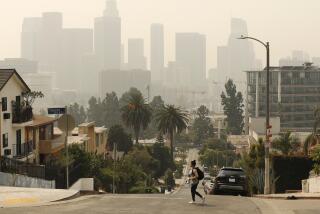The Threat of Losing a Life-Saving Shield : Washington must act to protect ozone layer
- Share via
The reaction is right on the mark: shock. William K. Reilly, head of the U.S. Environmental Protection Agency, is alarmed over the latest news about decay of the Earth’s ozone layer. Reilly’s reaction set just the right tone of urgency for the rest of Washington, which will be asked to do more to reverse the menace as the disturbing report sinks in around the world.
Reilly was responding to a report from the National Aeronautics and Space Administration that damage to the ozone layer is twice what earlier measurements predicted it would be by now. NASA made its observations last year and Reilly’s agency just finished analyzing them.
The ozone layer is a thin shield at between six and 30 miles into space that absorbs the sun’s ultraviolet rays before they can reach Earth. Without the ozone layer as a proper filter, ultraviolet rays can do severe damage. In high enough doses, ultraviolet rays cause skin cancer and eye cataracts, damage crops and cause genetic damage in plants and animals.
It is clear that industrial society inflicted the problem on itself with its use of chlorofluorocarbons, or CFCs, for products ranging from air conditioning to solvents and insulation. Long after this class of chemical compounds became almost indispensable to advanced nations, scientists discovered how severely chlorine, an element of CFCs, can damage ozone. A single chlorine atom can destroy tens of thousands of ozone molecules.
It is only slightly more than 15 years since the first scientific team theorized that chlorine, broken out of CFC compounds by sunlight, could be eating away at the ozone layer. Considering how slowly they have been known to move on other threats, national leaders moved with remarkable speed to deal with CFCs.
Meeting in Montreal in 1987, 57 nations forged a treaty calling for a 50% reduction in production of CFCs and other compounds that might attack the ozone layer. Last June, they met again in London, agreeing then to stop production in the industrial countries altogether by 2000 and to stop producing, by 2030, substitutes that could damage the ozone layer.
One reason that national leadership moved so fast is that so many lives are at stake. As Richard E. Benedick, who led the U.S. delegation to the Montreal conference, said in his recent book, “Ozone Diplomacy”: “It is no exaggeration to conclude that the ozone layer . . . is essential to life as it has evolved on Earth.”
EPA scientists estimated that it could mean 200,000 additional deaths from skin cancer over the next 50 years. Earlier estimates were 20 times smaller than that.
As Times writer Rudy Abramson reported Friday, one thing NASA discovered was that predictions made 12 years ago--that the ozone layer over the United States would be 1% to 3% thinner by now--were far too optimistic. The shield actually has diminished by 4% or 5%.
Even though it has a $135-billion investment in plants that must be converted to production of substitutes, the world chemical industry did not balk at the 2000 deadline. In fact, American companies nudged Washington back into line more than once when officials wanted to slow down.
Reilly, who led the U.S. delegation in London last year, said the new analysis may mean speeding up the deadlines for halting production. He stopped short of actually calling for changes in the 2000 deadline, although that should be one of the first items for discussion in light of the new evidence that the ozone layer is depleting at an accelerated rate.
American chemical companies seemed prepared this week to resist moving up the deadline, although some European countries already publicly favor halting CFC production as early as 1997.
What Washington must now decide is whether something that is “essential to life as it has evolved on Earth” is at all negotiable.






